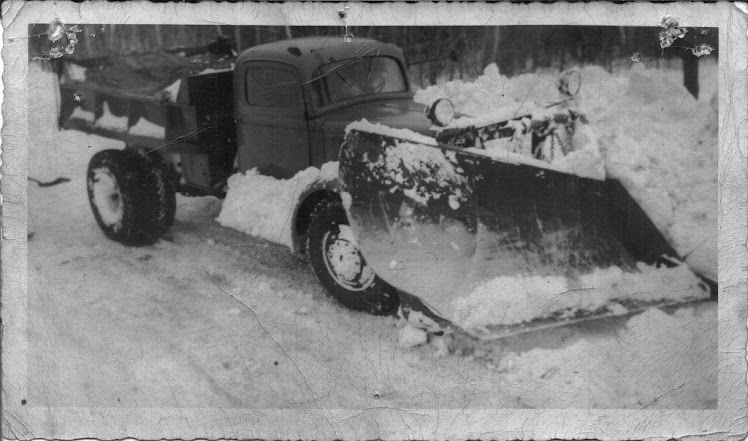There are two basic under-body scraper designs: Mop (trailing edge style) and folding moldboard (the old Root I-66 Interstate scraper). By far the Mop style is most common and most versatile. If an agency grades gravel roads with a truck mounted under-body scraper then the Mop style is by far the preferred method. It has a rugged 1" thick solid moldboard and few moving parts. With that being the case one must wonder why would you purchase any other design? I would speculate Leo Tift had the very same thought going through his mind when he designed/invented the folding moldboard scraper (jack-knife or vertical under-body scraper) while working as equipment foreman in the Michigan Department of Transportation Hastings Maintenance Garage back in the 1970's.
The disadvantage of a Mop style blade is it's design. The one-piece moldboard is hinged at the top which causes the scraper to lower in an arc (think of a compass used for drawing circles) resulting in a variable attack angle (the angle between road surface and cutting edge). Due to the attack angle varying two factors result: the cutting edge wears prematurely and the optimum attack angle for snow & ice removal is never achieved or only achieved for a short interval. What Leo Tift accomplished was to imitate a front plow and fabricate a moldboard with a center hinge that folds when raising resulting in a scraper that maintains a constant attack angle. With this design one can install a straight cutting edge with tungsten insert and, with a conservative driver, can operate all winter season without a cutting edge change while still achieving optimum results. The concept does work and works very well. Trucks are removed from service much more infrequently for cutting edge changes allowing them to remain on their plow routes. The optimum attack angle results in efficient and effective removal of snow & ice lowering the amount of chemical de-icers needed. There are a few caveats: 1.) optimum attack angle for snow & ice removal is a detriment to road grading/too aggressive and 2.) never use a curved cutting edge on a vertical style blade as to do so creates a very aggressive and dangerous attack angle which can result in snow plow truck roll-over.
 |
| Plaque from roadside park on M-86 dedicated to Leo Tift |
The disadvantage of a Mop style blade is it's design. The one-piece moldboard is hinged at the top which causes the scraper to lower in an arc (think of a compass used for drawing circles) resulting in a variable attack angle (the angle between road surface and cutting edge). Due to the attack angle varying two factors result: the cutting edge wears prematurely and the optimum attack angle for snow & ice removal is never achieved or only achieved for a short interval. What Leo Tift accomplished was to imitate a front plow and fabricate a moldboard with a center hinge that folds when raising resulting in a scraper that maintains a constant attack angle. With this design one can install a straight cutting edge with tungsten insert and, with a conservative driver, can operate all winter season without a cutting edge change while still achieving optimum results. The concept does work and works very well. Trucks are removed from service much more infrequently for cutting edge changes allowing them to remain on their plow routes. The optimum attack angle results in efficient and effective removal of snow & ice lowering the amount of chemical de-icers needed. There are a few caveats: 1.) optimum attack angle for snow & ice removal is a detriment to road grading/too aggressive and 2.) never use a curved cutting edge on a vertical style blade as to do so creates a very aggressive and dangerous attack angle which can result in snow plow truck roll-over.
 |
| Folding Moldboard Underbody Scraper |
The Leo Tift designed folding moldboard under-body scraper was originally manufactured and sold by Root Spring & Scraper in Kalamazoo under the name of the LT-1 scraper. It is now available from Root, Monroe Snow & Ice in Monroe, Wisconsin as well as others.
So there you have it; a bit of snow & ice equipment history and the role of a Michigan citizen and MDOT employee in the development. KUDOS to Leo Tift.
